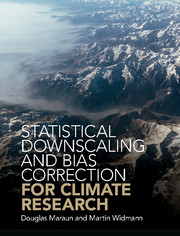Book contents
- Frontmatter
- Dedication
- Contents
- Preface
- Acknowledgements
- 1 Introduction
- Part I Background and Fundamentals
- Part II Statistical Downscaling Concepts and Methods
- 10 Structure of Statistical Downscaling Methods
- 11 Perfect Prognosis
- 12 Model Output Statistics
- 13 Weather Generators
- 14 Other Approaches
- Part III Downscaling in Practice and Outlook
- Appendix A Methods Used in This Book
- Appendix B Useful Resources
- References
- Index
11 - Perfect Prognosis
from Part II - Statistical Downscaling Concepts and Methods
Published online by Cambridge University Press: 27 December 2017
- Frontmatter
- Dedication
- Contents
- Preface
- Acknowledgements
- 1 Introduction
- Part I Background and Fundamentals
- Part II Statistical Downscaling Concepts and Methods
- 10 Structure of Statistical Downscaling Methods
- 11 Perfect Prognosis
- 12 Model Output Statistics
- 13 Weather Generators
- 14 Other Approaches
- Part III Downscaling in Practice and Outlook
- Appendix A Methods Used in This Book
- Appendix B Useful Resources
- References
- Index
Summary
State-of-the-art GCMs do not simulate regional-scale climate processes and also have a limited ability to represent resolved meso-scale processes. But GCMs often do have reasonable skill simulating synoptic-scale variability, such as the passage of cyclones and anticyclones. Perfect prognosis (PP) statistical downscaling exploits this skill to simulate regional climate. The approach builds upon synoptic meteorology and climatology, which analyses the relationship between synoptic scale and regional weather (Hewitson and Crane 1996).
DEFINITION 11.1 In PP statistical downscaling, a statistical model that links largescale predictors to local-scale predictands is calibrated to observed data. The statistical model is then applied to predictors simulated by climate models.
Comprehensive reviews about PP statistical downscaling methods for climate change studies have been published by Hewitson and Crane (1996), Wilby and Wigley (1997), Zorita and von Storch (1997), Fowler et al. (2007), Maraun et al. (2010a) and Schoof (2013); region-specific reviews are, for example, Hanssen-Bauer et al. (2005) for Scandinavia and Jacobeit et al. (2014) for the Mediterranean.
In the following, we will first introduce the assumptions underlying the PP approach (Section 11.1). The most widely used PP methods will be presented in Section 11.2. The skill to apply a PP method in a specific context is very much determined by the structure of the method. These issues will be discussed in depth in Section 11.3. Issues related to the use of different predictand variables, in particular impact-relevant predictands, will be summarised in Section 11.4. Crucial for any PP method to work sensibly under climate is a careful predictor choice. Relevant assumptions and potential predictors for temperature and precipitation will be discussed in detail in Section 11.5. Section 11.6 lays out the statistical construction of a PP method, with a focus on climate change applications. A cookbook is finally given in Section 11.7. Several advanced PP methods condition weather generators on large-scale atmospheric predictors. Given the peculiarities of these method types, we will discuss them individually in Chapter 13. The following discussions on assumptions and predictor requirements, however, apply equally to these methods.
- Type
- Chapter
- Information
- Statistical Downscaling and Bias Correction for Climate Research , pp. 141 - 169Publisher: Cambridge University PressPrint publication year: 2018

